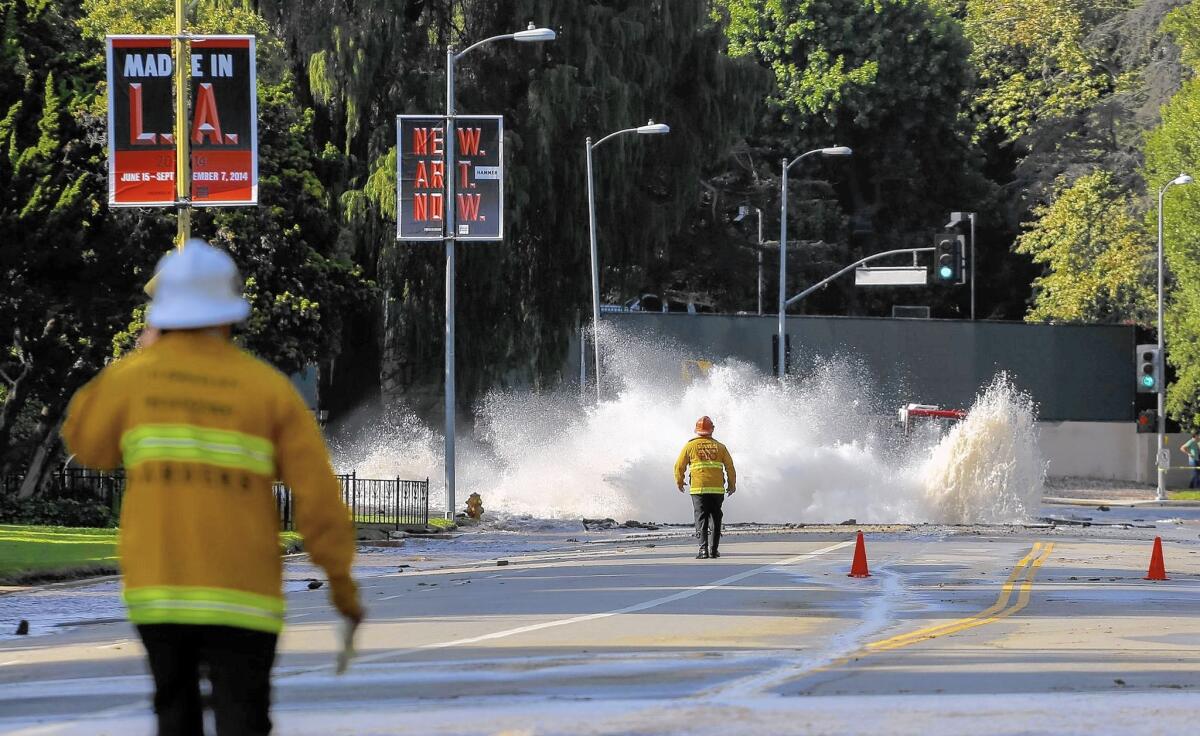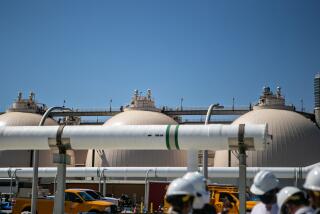L.A. identifies riskiest pipes in aging water system

As Los Angeles struggles to fix its decrepit water system, officials are most concerned about 400 miles of pipes that they say pose the greatest risk of breaking and causing major property damage.
The city issues letter grades to thousands of pipes in the sprawling water network based on the likelihood of failure and the potential consequences of a break. About 6% of the system earned grades of D and F, according to a Times analysis of Department of Water and Power data. Officials said replacing those pipes over the next 10 years is a priority. But it won’t be cheap.
The data, obtained under the California Public Records Act, provide a detailed and sobering view of the challenges Los Angeles faces in modernizing the infrastructure, parts of which date to the 19th century. Blowouts that damaged both private and public property have plagued the system. There have been more than 5,200 pipe leaks since 2010.
The data show that the average age of L.A.’s water pipes is 58 years and that two-thirds of the leaking pipes were installed before 1950. More than 5% of the DWP’s water main pipes have reached or passed their expected useful life, The Times’ analysis found, and another 8% are approaching the end of their usefulness.
More than 40% — 118,000 of the city’s roughly 275,000 pipes — received a grade of C or lower, the data showed. Two pipes involved in last summer’s major rupture on Sunset Boulevard near UCLA had received C and D grades. Water from that break inundated parts of the campus and caused millions of dollars in damage.
Since the UCLA pipe burst, city officials have been debating whether to spend more money to upgrade the system faster. Under the current plan, it would take about 300 years to complete.
But finding money for the crucial updates is a daunting challenge in a political environment hesitant to incur the wrath that rate increases would surely draw from L.A.’s water users.
“For a densely populated city like Los Angeles, a reliable water delivery system is not a luxury, it is critical to our very survival,” City Councilman Joe Buscaino said in a statement. “These statistics clearly show the need to invest in our infrastructure, and that will cost money.”
Mayor Eric Garcetti has promised not to increase water or electricity rates this year. His office noted the city boosted spending to maintain or replace water mains from $82 million to $112 million over the last four years.
Water main leaks and breaks occur on average about three times a day across the city, DWP officials said. The current rate of about 15 leaks per 100 miles is just shy of half the national average, officials say. The agency also said the number of water main leaks and breaks last year was 37% less than in 2006. The city has averaged nearly 1,200 leaks a year since 2010, The Times’ analysis found.
About 200 leaks each year are classified as “blowouts” that damage more than 100 square feet of asphalt or pavement, said Joe Castruita, director of water distribution at DWP. In September, DWP data showed that water line blowouts had increased significantly over the summer.
Pipe leaks since 2010 have been reported across the city, but some areas saw more than others, The Times’ analysis found. For example, neighborhoods in and around Hollywood Hills had more than 500 leaks combined, about 10% of all leaks in the city.
A lot of the pipes in the Hollywood Hills “are coming of age,” Castruita said. “Some of the higher elevations have to operate at a higher pressure than the surface streets. So those can be somewhat susceptible to leaks.”
Anastasia Mann said she was not surprised to learn just how dilapidated the city’s pipes had become, especially in her neighborhood. Just this year, the president of Hollywood Hills West Neighborhood Council discovered water gushing from a ruptured pipe on gushing water down her street.
“It was like a geyser,” she said. “I’ve seen so many water breaks over the years.”
The data showed that Westwood, Silver Lake, Venice, Woodland Hills and Beverly Grove were among the other neighborhoods with an unusually high number of leaks.
The agency is increasing the amount of aging pipe it replaces each year. This fiscal year, DWP will replace 130,000 feet of pipe and plans to replace more than that next year. Castruita said DWP planned to ask for a rate increase next year.
Officials said they planned to target mainline pipes rated F and D for replacement. Factors such as age, leak history, soil conditions and proximity to schools or hospitals contribute to a pipe’s poor grade. The average life expectancy of water main pipes, which make up the vast majority of pipes in the DWP system, is 100 years. The oldest water mains are more than 130 years old.
H. David Nahai, former head of the DWP, said the passage this week of Proposition 1, a bond measure that will fund water projects, will make new money available for infrastructure investments. But he said the bond alone won’t solve the problem. Ratepayers will simply have to pay more to update and repair old, broken pipes, he said.
“Nobody likes rate increases … but they are necessary,” Nahai said. “The department needs to make this case to the public.”
City Councilman Bob Blumenfield couldn’t say whether he would support increasing water rates without knowing more about how that would affect ratepayers in the hottest parts of the San Fernando Valley.
“I am loath to see any sort of increase, but I’m also a pragmatist and a realist,” he said.
More to Read
Start your day right
Sign up for Essential California for news, features and recommendations from the L.A. Times and beyond in your inbox six days a week.
You may occasionally receive promotional content from the Los Angeles Times.









